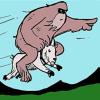Leaderboard
Popular Content
Showing content with the highest reputation on 09/16/2015 in all areas
-
It makes sense that there would be some variance in the tracks, surrounding a core that is consistent. This is a species that weighs 800 pounds and goes barefoot all its life. There will be injury and deformation. A subgroup that has lived in swamps for hundreds of years will likely have feet and tracks that are shaped by that environment. Another group may be inbred to a large degree and have genetic deformities. And I won't rule out the hoaxing of some samples. That said, I'm not qualified to question Dr. Meldrum, Krantz, or any other true expert in the field of biomechanics.1 point
-
Meldrum is still a scientist, is he not? Why does he stand behind both the Freeman and Wallace-made tracks as being the real deal? Yes I see how it works- selective science.1 point
-
Interesting that it is from 1968 and addresses the analysis of evidence that some claim does not and has never existed. Sanderson did his homework and he used established, top notch experts back in the 60's to accomplish this. I find the description of the beds interesting. Some may recall that I have hypothesized bigfoot use composted middens to generate heat to stay warm in their shelters, and that this contributes to their stench. The beds, as described, composed of layers of rotting vegetation, excrement, and urine, overlaid with fresh vegetable matter as described would generate heat in the same manner as a compost pile and seems to support the hypothesis.1 point
-
Sigh: I hope this puts to rest the myth that no potential sasquatch scat exists. There's plenty of scat out there that is found in association with sightings and tracks that does not conform to known animals, as I said earlier. http://www.bigfoot-lives.com/html/more_evidence_that_bigfoot_exi.html short version of Ivan Sanderson description of analysis, 1968. Other Photos. http://www.bigfootencounters.com/images/scat.htm comparative photos http://www.bfro.net/GDB/show_report.asp?id=22358 Someone with a similar experience to mine, though he didn't see or interact with it. https://www.facebook.com/video/video.php?v=168451576528987 A comparative video, 5 plus minutes. https://bigfoothistory.wordpress.com/tag/bigfoot-scat/ second account on the page is about a published and tenured anthropologist with a collection of bigfoot scat, just to establish here that there are actual scientists collecting this stuff. https://bigfoothistory.wordpress.com/2013/07/28/1998-marble-mountain-wilderness-california-man-collects-bigfoot-scat/ weird scat-related account. I consider the credibility of this marginal. http://www.bfro.net/GDB/show_report.asp?id=8259 An account from a PhD. Physiologist also witnessed by a veterinarian. The Physiologist gives his credentials for your verification. http://www.bigfootencounters.com/articles/argosy.htm a longer version of Sanderson's analysis. http://www.alamas.ru/eng/publicat/DNA_of_Bigfoot_e.htm A rollup of various DNA finding predating the Ketchum analysis. Note that the conclusion here is that bigfoot DNA is part human.1 point
-
You think it might have to do with the relative, ahem, "size" of a bigfoot? Where's Wag when you need him? So now you're complaining that I gave you access to an entire thread that discusses the existence of and pros and cons of fecal samples? You've given him *work* and *thinking* to do. He doesn't want that. See, this is why scientists don't care what the hell we think. They'll publish the results when they're ready and 'til then...do your own thinking. He said there were studies, he should provide them for us. I'm calling his bluff, I want to see the cards. Hey, I pointed you in the right direction. You need someone to hold your hand? And I said there were analyses, not studies.1 point
-
So now you're complaining that I gave you access to an entire thread that discusses the existence of and pros and cons of fecal samples?1 point
-
I'll tell you how prepared this one was. We were on no road no trail. The old road in which we found the tracks was not in any current use for any reason, that was plain. (Logging roads frequently return to the wild when the logging's done.) And the trackway looked old and even though I don't remember my exact thoughts, I am dead sure I didn't expect to find what was at the end of them. Nor am I sure I would have wanted to. Three-quarters to an inch deep in stuff we weren't denting with lug soles and heavy packs. DWA, sorry, but given how much bigfoot is on your brain, and your less than stellar evidence sussing skills demonstrated back in April of this year, I am not going to put much stock in anything you think is bigfoot evidence.1 point
-
Dude, you're as Google capable as I am. Your complete lack of effort indicates a complete lack of interest in doing anything other than sniping. https://www.bing.com/search?q=bigfoot%20feces&form=EDGENT&qs=PF&cvid=0b53c18722ab4b3c80f7b29792a2fc2f&pq=bigfoot%20feces&PC=DCTE http://bigfootforums.com/index.php/topic/46905-sasquatch-feces/1 point
-
Great, which lab did the testing? Where were the results published? Right. I was fourteen at the time, had tried to interact with a pregnant female about an hour earlier, and as a result got stalked and intimidated by three males. Under the circumstances I was more concerned with other things and really didn't know at the time that there were people who actually study feces. And yes, there have been analyses of bigfoot feces over the years. Generally the conclusion is that they don't match any known species. The best that provides is more probable cause under the circumstances.1 point
-
Bodhi, you're responding to a guy who has had a bigfoot leave a big steaming pile of feces in the middle of a trail as a very clear message.1 point
-
Any bigfoot track could have alternate explanations: mistake, hoax, known animal, etc. Until, or if, any one track actually leads to either a bigfoot or confirmed unknown primate DNA or some other result that will actually support the claim, then tracks remain ambiguous. I must concede nothing of the sort. There is enough to investigate bigfoot as a modern myth and social construct, not as an extant animal. That is my interest. I have stated such many, many times on this forum. I find all aspects of the myth interesting. Particularly how proponents respond to challenges to the myth. Such as this very thread. DWA, I am well acquainted with the evidence, I am just not impressed by it. If the evidence is so convincing, then why does the world, at large, remain unconvinced? Ok, so you admit to being subjective. "Could have alternate explanations" does not mean "does have alternate explanations". That doesn't eliminate the fact that there is probable cause to investigate, which you seem to accede. You say that there needs to be a second form of evidence to back it up, but that second form of evidence has to be provided by someone acting on the probable cause to investigate. Then you go completely subjective with the social construct bit. I don't view you as challenging a myth. I view you as the spiritual successor to Powell: "One of Powell's statements that I find most damning is "A brief review of some conclusions that must be accepted in the present status of the science will exhibit the futility of these attempts.", (connecting Native American culture to contact with "so-called races of antiquity"). Note that his statement is heavily qualified by a "brief" review of "some" conclusions that "must be accepted" in the "present" status of the science to pronounce such study "futile". This subjective position is not in consonance with the Smithsonian's original objective purpose to "increase the diffusion of knowledge among men". The statement is also self-contradicting because it refers to the "present status of the science", but hampers its advancement by subjectively limiting further study in certain areas. If what he believed to be futile is futile, then it would prove itself futile on its own." And, oddly, I've expressed interest in understanding why some people are so uncomfortable with the existence of bigfoot that they attempt to shield themselves by limiting the concept to a social construct.1 point
-
No objective physical evidence? Seems to me that a footprint is objective physical evidence. A trackway is objective physical evidence. Look, dmaker, you must concede that by definition there is probable cause to investigate bigfoot. Otherwise you wouldn't be here, bothering to talk about it, right? If that's not the case, then the only other reason for you to be here is to proselytize your own belief system. Which is it?1 point
-
There is, in fact, evidence that the government has suppressed evidence of giant skeletons and cultural artifacts going back to the latter half of the 1800s. FarArcher had a good post and referred to things being sent into the Smithsonian black hole. This is not conjecture, it actually became a matter of policy (The Powell Doctrine) for political reasons not long after the Civil War. At the time there was a body of contemporary evidence building from investigation of Indian Mounds that a species of giants had existed in North America and that there was interaction with the Old World that predated Columbus. There was an active counter effort by Thomas Powell, the first Director of the Smithsonian's Bureau of Ethnology to suppress any of this emerging school of thought for three reasons: 1. To contravene any counterclaims to the doctrine of Manifest Destiny. 2. To contravene, in an attempt to limit their growing strength, any evidence that could be construed to support the Mormon doctrine that Biblical figures had visited North America or that lost tribes had migrated to North America prior to Columbus. 3. To portray Native Americans as nothing more than aboriginal to morally justify by contemporaneous standards their resettlement and the confiscation of their lands.​ I am reposting below a post I made to a Giants thread during discussion of the Book "Giants in America" by Richard Dewhurst. I will also bump that thread back up for the enjoyment of new members. "In reading about the Powell Doctrine on pages 5 - 12, the dismissal of American archeological finds seems pretty overt. For those who don't yet have the book, Major John Wesley Powell was a geologist and explorer. After the Civil War, he occupied himself by exploring, most notably the Colorado River from Wyoming to the end of the Grand Canyon. His expedition, as the first to officially explore the Grand Canyon, complete with a photographic record, was famous. In 1879, Powell was appointed as head of the Smithsonian's new Bureau of Ethnology, and held that position until his death in 1902. Powell's first report to the Secretary of the Smithsonian was titled "On Limitations to the Use of Some Anthropologic Data". In it he commented that "the uses to which the material has been put have not always been wise". Up until then such material had been shared freely without restriction, to include the conclusions of those researching the material, who frequently theorized, based on the artifacts they were finding, that there had been contact between ancient cultures from Europe and the Mediterranean, and the Americas. Powell specifically objected to the use of the information to connect Native American culture to "...so-called races of antiquity in other portions of the world". I don't want to stray into political or religious ground here, but I will point out for purely historical context that at that time there was a rapidly growing religion based in the American West founded upon the belief that there had been contact between Native Americans and a person of antiquity from another portion of the world. Also, the concept of manifest destiny was in full bloom, which was, in part, predicated on the right to displace "primitive" native cultures. The author suggests that Powell did not want to elevate the status of Native Americans by promoting contact with, or descent from "lost tribes". Powell himself states that "...there is no need to search for extra-limital origin through lost tribes...". He then singles out artifacts that he considers primitive from the American Southwest and states that it is improbable that anything found anywhere else in America would be any more valuable. One of Powell's statements that I find most damning is "A brief review of some conclusions that must be accepted in the present status of the science will exhibit the futility of these attempts.", (connecting Native American culture to contact with "so-called races of antiquity"). Note that his statement is heavily qualified by a "brief" review of "some" conclusions that "must be accepted" in the "present" status of the science to pronounce such study "futile". This subjective position is not in consonance with the Smithsonian's original objective purpose to "increase the diffusion of knowledge among men". The statement is also self-contradicting because it refers to the "present status of the science", but hampers its advancement by subjectively limiting further study in certain areas. If what he believed to be futile is futile, then it would prove itself futile on its own. The "Powell Doctrine" remains in force today even as contact with some of those races of antiquity becomes increasingly evident. To me, there is sufficient cause to hypothesize the past existence of an extinct race of very tall people with its own culture in North America. I will also note that recent DNA findings in Europe show that a genetically different race of humans (non-Neanderthal) once occupied Europe and have since disappeared (died out?) prior to the inward migration of the current human inhabitants (just read the article before coming to this site, and find that the link is now gone from the news site where I found it. I'll have to dig up the source article later). It makes me wonder. Did a race of people of large stature with their own culture once exist? Did they exist in both Europe and the Americas? If so, what caused them to die off? When ancient lore refers to "giants in the earth" in those days, or asserts that a given structure was built by giants, are they simply referring to this putative extinct race of people?" ​1 point
-
Thanks for the replies but I asked a specific question. If this independent lab arrives at the same conclusions as did Dr. Ketchum, and they do duplicate her work, will that vindicate her? As far as the debacle of her paper, I believe a lot of people take other's word for it that it was such a sham without enough knowledge of the subject themselves to know on their own. I don't have the expertise to know how accurate all these claims are on either side, but I suspect there's some hyperbole on the part of those trashing her results since all of her testing was done in university labs that use thorough washing techniques to remove contaminants, and "all" those samples could not have been contaminated as some skeptics of her work have claimed. It just doesn't sound feasible that everything must be contaminated, but it sounds more like some who are biased against bigfoot's existence have assumed it must all be contaminated since they don't believe it exists. On the issue of how she interpreted her data, and the conclusions she arrived at, as I commented, I really can't speak to that, but if you start having others duplicate her results and conclusions I believe some may need to reassess their prior stances regarding her work.1 point
-
And this is why IMO if possible it would be better if the "sniper" Guy was someone who had a visual before so they know what they're letting themselves in to. I've had my visual and I think it was a near perfect one to gauge these things albeit I was quite young and even though 20 or so years has passed now, I still have enough in my memory to know I personally wouldn't shoot even though I'm nowhere near experienced/qualified enough to anyway, but that doesn't stop me understanding and agreeing that shooting one is the only way these things will ever be "discovered".1 point
-
Men are and have been executed based on eyewitness testimony, under the principle of finding the facts to reach the truth. I see scientists presenting an entire "reconstruction" of a Gigantopithicus, and the only fossils available are a partial lower jaw and a few teeth. Other orthodox scientist have put forth that this species was likely bipedal - and go on to give us insights on how it lived. There are countless newspaper articles with accompanying photographs of giants unearthed in the nineteenth and early twentieth century, and time and again, reports tell of the skulls or skeletons being sent to the Smithsonian. Oddly, the Smithsonian has none on display, and when asked where the remains that were sent to them are - they'll tell one that they don't exist. Science has a narrative all their own. If you're of the scientific priesthood, your prime objective is to be published in a sanctified, sanitized, scientific periodical, peer-reviewed, for purposes of separating yourself from the unwashed, lesser scientists who are not published. God forbid one provide evidence or question their authority, lest one be declared anathema by the self-appointed, self-regulated scientific clergy. The preponderance of evidence ranges through the millennia - and to ignore that evidence - narratives both verbal and written - is a forced attempt to swim upstream. I personally don't care if one is a skeptic. I used to be. And when that big *** ran at me for 60 yards, missing me by twenty feet, and continued on another 20 yards behind me, there was no mistaken identity, no hallucination, no mistaken identity, and certainly not a mistaken perception. I am a well trained observer in the wild - I never shot at movement - in fact, I always took care to be certain of what I was seeing, identify whether friend or foe, and when foe - not just shoot him, but to place my shot. It's easy enough to learn if you want to make sure you never, ever kill one of your own, just because you were in a hurry. I was a skeptic. But I wasn't a fanatic about it. I didn't care about it enough to even disagree. As a true skeptic, I just didn't care that much one way or another. Often, I see some trying just a bit too hard. Maybe they're frustrated they are not among those who have witnessed something spectacular. In such a fashion, maybe they think this helps cover the fact that they either don't get out to remote areas much, or that they themselves are incapable of seeing one of these critters due to their own incompetence. Either way, I don't care - from the other side of the fence. Some are pretty sure. Some know. Some can't.1 point
-
As much as I can't stand that Dmaker would be correct, he is, there isn't any real evidence. BUT, there are folks on here that supposedly have regular contact, but they just want to keep it to themselves, the world isn't worthy.1 point
-
DWA, every single bingle gingle zingle time you talk about testing and evidence in the same sentence, you reveal your complete lack of understanding of both of those terms.1 point
-
You can keep comparing bigfoot to other things that are proven to exist all you want. It will not change the fact that bigfoot remains unproven. You could change that, you know, by providing some objective evidence for science to test. Instead you spend your time desperately trying to convince the world that bigfoot is virtually proven. Mistakes, lies, poor perception, etc, etc can easily explain bigfoot in its entirety. Why should I trust your powers of perception? Why should I accept your highly subjective version of events that only you witnessed? Particularly when there is no evidence that any event even occurred? Hence, the problem inherent in anecdotal evidence. Why should I listen to your highly improbable account? There is no evidence to support it, so why should I listen to you? Why should I trust in your ability to interpret what you call tracks that step over high fences? Honestly, that sounds ridiculous to me. I am certainly not going to accept it as evidence of an unclassified, large, bipedal ape running around North America. Extend that logic to every other useless bigfoot anecdote and the entire thing comes tumbling down. Without decent supporting evidence, why would anyone believe a single bigfoot story? That seems to me to be the perplexing question here.1 point
-
"Know" is a relative term. Nobody knows in the purest sense if bigfoot does not exist. But there is something called the educated guess and this is how many questions of knowing and not knowing are answered. If I knew nothing about bigfoot lore and bigfoot history I would be likely to say something like "anything's possible". But after having been exposed to the issue over a substantial length of time I can weigh it either positively or negatively for than matter. You know this, we all know this, we all know the concept of the "educated guess." So perhaps it' better to say , "I know that each and every piece of evidence I've seen has not been suitably good enough to allow me to draw a positive conclusion in favor of bigfoot existing. By being a person who has never seen one of these creatures in the wild and accepting they do not exist. Which is where I am not willing to accept and will not until the truth is out. They exist and I have accepted it and it does not matter if any body else does not want to. The truth will always be on my side no matter how many times people try to hide it. Ok, you guys are just being stubborn. This whole thing didn't start with a hypothetical thread. It started with consistent reports dating back hundreds of years, including Native American history. You can run from, rationalize, deflect, and deny; but you can't dismiss the fact that a body of evidence exists. The best you can do is ignore its totality and attempt to discredit it item by item. That takes true subjectivity (note this is the opposite of objectivity). From my perspective, not ever having heard of such a thing as a bigfoot at the time when I first came face to face with one, I was pristinely unprepared for the reality. At that point I learned they existed, but still didn't know what the heck they were. And at this​ point the debate is moot to me. What does interest me is understanding what drives your subjectivity. What is it about the existence of bigfoot that leads you to so adamantly pursue denial that you jump into a forum about something in which you do not (want to) believe? ​ The body of evidence, as you put it, is mostly anecdotal. Any physical evidence that has been scientifically tested, to date, has failed to support the claim. There also remains evidence that is putative at best. For example, tracks. No track has ever lead to any objective, testable evidence that has supported the claim. Ever. In the history of bigfoot. Native legends are open to interpretation. I feel that many of them have been shoehorned to fit the bigfoot myth purposefully. Your own claim of encountering a bigfoot is just one more anecdote on the pile. There are plenty and plenty of those. Not a one of them has ever lead to any proof. This body of evidence is not being denied by me. I am simply describing it as I see it. How is that denial? How is it possible to deny something that has never been proven to exist? If it pleases you to call someone a denialist for properly categorizing evidence, then knock yourself out.1 point
-
Something bothers me. If Ketchum's work with purported bigfoot samples is as shoddy as the paper she presented makes it look, what else has she done poorly? I was thinking about this Friday, Sept 11 ... Ketchum takes credit for identifying human remains at the WTC complex after the 9-11 attack. I wonder if she did that as poorly? Leaves me with an uncomfortable feeling for the families. MIB1 point
-
IMHO you're sorta mixing and matching terms in a misleading way. "Habitat" is a place a thing can live long term sufficient to meet all their needs. In the case of a bigfoot report, there's no connection ... they can readily pass through terrain that is not "habitat" just as we do. Example? Under water. I cannot live long under water but I certainly can, and do, pass under water, and could potentially be observed there, when I'm swimming. It would be as mistaken for an observer who saw me underwater to infer that it is my habitat as it would be for an observer who saw a bigfoot on a salt flat to infer that that's their habitat. The implied connection between being observed in a place briefly and living there long term is invalid. In other words, I don't have any real qualms about a bigfoot report from Nevada. MIB1 point
-
I was in the woods when I received a text telling me about Ray's hospitalization several days ago. I returned home last night, and today was the first opportunity I had to visit Ray. I just walked in the door from doing so. Ray is in good spirits, and for a dying man, he looks great. He is ready for the impending transition. We spent our hour and a half together talking about bigfoot, astronomy, interesting people, his rich and unique life, and other stuff. He told me about his books, some of which have yet to be published. He shared insights and stories. It was great. Back in 1997, I was road tripping with my soon-to-be (and now ex-) wife. I subscribed to the WBS newsletter, the Track Record, at the time, so I took a chance and called Ray Crowe when we were in Portland, OR. I was hoping to see the bookstore and some of his sasquatch artifacts kept in his bookstore's basement where the WBS met every month. Ray told me on the phone that all that stuff was over at Larry Lund's home because of a flood or something or other in the bookstore. Ray gave me Larry's number, which I called, and my ex and I spent four or five hours with Larry that night. The evening blew my mind. The thought that there were actually people into this stuff I guess hadn't really occurred to me at that point. I credit (or perhaps "blame" would be a better word) that night with accelerating me to wherever I find myself today. It started with that phone call. It started with Ray. Today, I thanked Ray for this. I'd be lying if I said I did this with dry eyes. I feel like we in the PNW all owe Ray a lot. He started the monthly meetings here in Portland, of which echoes can now be seen in HopsSquatch. He carried on the tradition of newsletters pioneered by the Bay Area Group and the Bigfoot Co-op (am I showing my age now?). He suggested to us that we always wear our "skepticals" while reading his newsletter, as it was raw data, no filters added, which is good advice for all bigfooters. He's not dead yet, but he is on his way to check out. He is/was not only a catalyst for my life path, I am happy to call him a friend. Think positive thoughts for friend of the 'squatch, Ray Crowe.1 point
-
1 point
This leaderboard is set to New York/GMT-05:00








